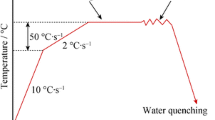Abstract
This work deals with the reheating process for semi-solid thixoforming of ZL101 (AlSi7Mg) alloy. The semi-solid state can decrease the viscosity and the resistance while sheared because of the evolutional behavior, which is characterized by a solid-like behavior at rest and a liquid flow during shearing. The microstructure evolution of ZL101 alloy at different temperatures from 540 to 580 °C has been studied. Results show that the eutectic temperature can affect the transformation speed of semi-solid structure. Semi-solid microstructures with high solid fraction can be obtained by controlling the reheating time in less than 20min, while at the temperature lower than the eutectic temperature it needs more than one hour. Another character of semi-solid ZL101 alloy is the segregation of microstructures in semi-solid state, in which the liquid phase between the solid phases can flow freely and lead to the shrinkage of the sample during the heating process. As the holding time goes on, more shrinkage holes appear and change the surface of the specimen. These shrinkage holes are replenished by the liquid phase during compression deformation, resulting in the segregation of the components.
Similar content being viewed by others
References
NAFISI S, GHOMASHCHI R. The microstructural characterization of semi-solid slurries [J]. Journal of Metals, 2006, 58(6): 24–30.
MOHAMMADI H, KETABCHI M, KALAKI A. Microstructure evolution of semi-solid 7075 aluminum alloy during reheating process [J]. Journal of Materials Engineering and Performance, 2011, 20(7): 1256–1263.
PARSHIZFARD E, SHABESTARI S G. An investigation on the microstructural evolution and mechanical properties of A380 aluminum alloy during SIMA process [J]. Journal of Alloys and Compounds, 2011, 509(40): 9654–9658
QIU J M, XIAO H, WANG J, et al. Microstructure evolution of semi-solid ZCuSn10 copper alloy during reheating process [J]. Chinese Journal of Materials Research, 2015, 29(4): 277–283 (in Chinese).
LOURENCATO L A, ZOQUI E J. Evolution of microstructure in semi-solid of Al-2wt%Si-0.5wt%Mg and Al-4wt%Si-05wt% alloys during isothermal holding [J]. Advanced Materials Research, 2014, 1082: 152–166.
LIU Y Z, LUO X, LI Z L. Microstructure evolution during semi-solid powder rolling and post-treatment of 7050 aluminum alloy strips [J]. Journal of Materials Processing Technology, 2014, 214(2): 165–174.
KUMAR S, DAS P, TIWARI S K, et al. Study of microstructure evolution during semi-solid processing of an in-situ Al alloy composite [J]. Materials and Manufacturing Processes, 2015, 30(3): 356–366.
ZHU X W, WANG R C, PENG J, et al. Microstructure evolution of spray-formed hypereutectic Al-Si alloys in semisolid reheating process [J]. Transactions of Nonferrous Metals Society of China, 2014, 24(6): 1766–1772.
FENG K, HUANG X F, YING M A, et al. Nondendritic microstructure evolution process and mechanism of ZA74 magnesium alloy [J]. Chinese Journal of Nonferrous Metals, 2013, 23(3): 635–644 (in Chinese).
WANG J G. The mechanism for the semisolid microstructural evolution of the AZ91D magnesium alloy fabricated by strain induced melt activation (SIMA) [D]. Changchun: Material Processing Engineering, Jilin University, 2005: 30–32 (in Chinese).
KATTAMIS T Z, PRICCONE T J. Rheology of semisolid Al-4.5%Cu-1.5%Mg alloy [J]. Materials Science and Engineering A, 1991, 131(2): 265–272.
LI Y D, HAO Y, CHEN T J, et al. Effects of different primary microstructure on semi-solid melting behavior of AZ91D magnesium alloy [J]. The Chinese Journal of Nonferrous Metals, 2004, 14(3): 366–371.
ATKINSON H V, LIU D. Microstructural coarsening of semi-solid aluminum alloys [J]. Materials Science and Engineering A, 2008, 496(1/2): 439–446.
ZHANG X L, LI T J, TENG H T, et al. Microstructure evolution of as-cast AZ91 magnesium alloy during isothermal heat treatment [J]. Foundry, 2007, 56(10): 1048–1052 (in Chinese).
Author information
Authors and Affiliations
Corresponding author
Additional information
Foundation item: the National Natural Science Foundation of China (No. 51635005)
Rights and permissions
About this article
Cite this article
Luo, S., Yu, H., Qiu, H. et al. Microstructure evolution during remelting of high solid fraction ZL101 alloy. J. Shanghai Jiaotong Univ. (Sci.) 22, 712–718 (2017). https://doi.org/10.1007/s12204-017-1885-6
Received:
Published:
Issue Date:
DOI: https://doi.org/10.1007/s12204-017-1885-6




